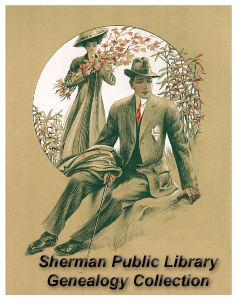 The site of the old Sanborn Ranch is just east of Whitesboro off U.S. Highway 56. Sanborn is credited with the first barbed wire fence in Texas. The Denison Herald Sunday Morning, June 25, 1972 BARBED WIRE WHITESBORO - The end of the open range era in Texas and the Southwest began with a project in this Grayson County town. Barbed wire was introduced here in 1878 when a Chicago syndicate headed by H. B. Sanborn bought a 35,000 mile (sic acre) ranch each of Whitesboro to allow Joseph Glidden, the inventor of barbed wire, to showcase his product. Before Glidden arrived here, there were no fences on any of the blackland prairie or pasture land. Only split rail fences were used for corrals. Glidden fenced 35,000 acres with barbed wire and curious ranchers from throughout Texas came here to examine the new fence, signalling the end of the open range. Sherman Daily Democrat August 13, 1939 A few strands of the first barbed wire fence to hum the knell of the open range in Texas still hang to posts on the famous Frying Pan ranch west of Amarillo. Decaying beside Highway 82, 10 miles west of Sherman, is the house the first distributor of barbed wire built. The 2 relics - the rusted wire and the crumbling 2-story house - are richly historic, for they played a part in the changing of the old order in the cattle country. They stand today because J.F. Glidden of De Kalb, Illinois became angry one morning back in 1874. His cattle had broken down his fence of smooth wire around a pasture. While repairing it Glidden noticed hanging to the wire some of the staples used in fastening the strands to the posts. The staples were sharp. Glidden had an idea, one that would revolutionize the west. His idea was to place barbs on the wire, but not until he had obtained a patent in November 1874, did he realize the possibilities of his invention. He and I.L. Ellwood patented a machine for making barbed wire and built a factory at De Kalb. Five tons were made the first year and he hired Henry B. Sanborn. Sanborn was sent to Texas where he was thoroughly disliked, but today there is a Texas village named Sanborn and a city park in Amarillo by the same name. Sanborn tired to convince big-scale stockmen the wire was practical. They snorted at the idea, but Sanborn had a carload shipped to Texas. To prove to skeptical stockmen that cattle and horses "would get used to barbed wire," Sanborn bought a ranch 10 miles west of Sherman and fenced it. FATHER OF AMARILLO Gradually the stockmen, more especially the small ranchers and settlers, came to favor barbed wire. Sanborn made a fortune. He invested most of that fortune in the 125,000 acre Frying Pan ranch, where he put it under fence, the first major ranch on the plains to be encircled by humming barbed wire. Later Sanborn helped found Amarillo and won the title of "Father of Amarillo." The old house at Sherman is in need of repair. Most of the "Glidden wire" on the old Frying Pan is gone, but so had the old west barbed wire changed. Barbed wire stretched endless miles in every state. Even Texas' famous boothill graveyard - the one at Old Tascosa not far from the Frying Pan - is fenced with barbed wire, although many of the men sleeping there carried wire-cutting instruments in their saddle bags. Barbed wire didn't come without a fight. Many a trigger was pulled over fence building and barbed wire cutting and today in Coleman County - near Jim Ned creek - is a fence with each wire tied between every 2 posts. Wire-cutters cut it between the posts. It was tied back together. Perhaps the greatest amount of barber wire ever used on a single acreage was strung around the 3,000,000 XIT ranch the state of Texas swapped for the capitol building in Austin. Within the 2 years after the ranch was established it had 800 miles of barbed wire. Later cross fences increased the amount to 1,500 miles. (The King Ranch in South Texas is larger than any other ranch under fence today, but the Kings use smooth wire, enough of it to reach from Brownsville to Chicago.) BRINGS CHANGES Although barbed wire was hated and cursed by ranchers and cowhands who were changed from line riders to fence riders, the product of Mr. Glidden's fit of anger back in 1874 finally became a weapon that led to still greater changed in the cow country. Natural developments in the cow business had brought competition, mainly between the large operators and the small independents. Ten years after barbed wire was introduced a group of small operators organized and built a 40-mile barbed wire fence north of the Canadian river. It was a drift fence to keep back the cattle of the big companies to the north. The cattle usually drifted southward into the well-watered river breaks during the winter. Although intended solely as a protection, the fence proved to be a thing of revenge. The winter it was built came the great blizzard of 1885-1886. When the blizzard struck the cattle turned tail and headed south. Against the drift fence thousands and thousands died. As long as a cow could stay on her feet and keep moving she had a chance to survive the blizzard, but once she stopped she was doomed. The next spring the drift fence was lined on the north with decaying carcasses. The loss was great, but it won a point for the small operators. Barbed wire had come to stay. The open range was gone. The nester's most effective weapon was barbed wire and he used it. The cow country became a settlement.  Grayson County Firsts Whitesboro History Susan Hawkins © 2024 If you find any of Grayson CountyTXGenWeb links inoperable, please send me a message. |